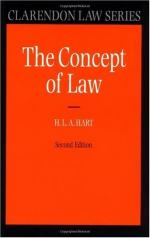
|
| Name: _________________________ | Period: ___________________ |
This test consists of 15 multiple choice questions and 5 short answer questions.
Multiple Choice Questions
1. What do the laws of judicial practice not define?
(a) Jurisprudence.
(b) Punishment.
(c) Violations.
(d) Prison time.
2. How does Hart qualifies Province of Jurisprudence Determined, according to Chapter 2?
(a) As a bad attempt to analyze law.
(b) As the most serious attempt to analyze the concept of law.
(c) As an effort to change the law.
(d) As an attempt to prevent laws from applying.
3. What are some primitive society rules by?
(a) Laws.
(b) Rules.
(c) Customs.
(d) Moral.
4. What do criminal laws specifies must be followed?
(a) The spirit of the law.
(b) The letter of the law.
(c) Duties.
(d) Morality.
5. What is in a sense general?
(a) Legal interpretation.
(b) Legal retribution.
(c) Legal reach.
(d) Legal control.
6. What aren't obligations, according to Austin and others?
(a) Natural.
(b) Typical.
(c) Obligatory.
(d) Binding.
7. Who make laws?
(a) The ones generally obeyed.
(b) Congress.
(c) Everyone.
(d) The king.
8. What does the distinction make sense of, according to Hart?
(a) How moral is structured.
(b) How custom is structured.
(c) Many difficulties previously unsolved.
(d) How law should work.
9. Who does the populace trust to determine the specificity of the laws?
(a) Vigilanties.
(b) Police.
(c) Congress.
(d) Certain bodies such as courts.
10. How are laws obeyed?
(a) Characteristically.
(b) Barely.
(c) Usually.
(d) Fully.
11. What is the first question Hart identified?
(a) Who needs laws.
(b) What makes law obligatory.
(c) Who wants laws.
(d) Who create law.
12. What are 'real' rules, according to Hart?
(a) Those society agree must apply to all.
(b) Those created by elected officials.
(c) Those descending from morale.
(d) Those society believe must be obeyed.
13. Which status is the closest to the Austin/coercive order model?
(a) Civil statutes.
(b) Secondary status.
(c) Penal status.
(d) Primary status.
14. What is it best to try and acquire according to Hart?
(a) The word of the law.
(b) The understanding of the law.
(c) The spirit of the law.
(d) The idea of law.
15. What would breaking the rule allow some individual to do?
(a) Allow for better laws to be created.
(b) Help them.
(c) Get them into prison.
(d) Improve society.
Short Answer Questions
1. How do some react to rules themselves?
2. What is law?
3. What are imperatives backed by?
4. What do making laws differ from?
5. What do many not realize habits are?
|
This section contains 377 words (approx. 2 pages at 300 words per page) |

|




